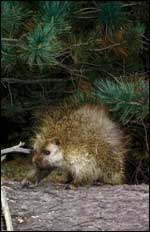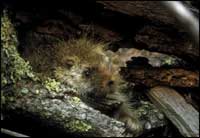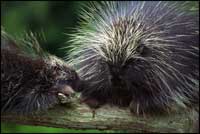Porcupines
Bowlegged and pigeon-toed, the porcupine slowly ambles along, swinging its fat body from side to side, muttering to itself. A pleasant enough creature when left alone, the porcupine is quick to defend itself at the slightest threat. With a top speed of little more than a fast waddle, it can escape very few animals; however, its defensive weapons are so effective, it has no need for speed.
These weapons, which are really modified hairs, take the form of a protective body armor of needle-sharp quills. Researchers estimate the porcupine has more than 30,000 of these quills with as many as 100 to 140 growing from each square inch of skin. Only the nose, legs, and underside are unprotected. The rest of the body, from eyebrow to tail tip, is covered with prickly spines.

A heavy underfur keeps the porcupine warm in the winter, then is shed during hot weather.
The stiffest, longest, and most numerous quills are found on the back and tail. Those on the sides are more slender and flexible. Quill length varies with the area of the body on which they are found and the stage of development. Just as animal hair is shed and replaced, so are the porcupine's quills. New ones begin developing within a few days after the old ones are shed or removed, and they grow about one millimeter every two days until fully developed. Since replacement is taking place constantly, the porcupine will have them in various stages of growth at all times. Once a quill is fully formed, the root closes, and usually no bleeding occurs when the quill is removed from its ready-release socket.
The position of the quills can be a good indicator of the porcupine's mood. When the animal is relaxed and unafraid, the quills lie flat, hidden under a layer of long guard hairs. If the animal is disturbed or threatened in any way, the quills stand erect and the porcupine is ready for battle. The slightest touch on a single quill or guard hair also brings them erect, turning the creature into a living pincushion. Each quill is under complete muscle control and can be raised or lowered instantly.
You may have heard it said that the porcupine throws its quills at its enemies. This is not true, but it is easy to understand why the idea persists. When a porcupine senses danger, it lifts its quills into the vertical position. The next step is to waggle its tail from side to side. If these warnings are ignored and the threat continues, the porcupine whirls around and presents its prickly backside to the enemy. With teeth chattering and tail thrashing, it advances in a backward position. During this violent tail lashing, some of the older quills that were about ready to be shed are dislodged. Occasionally one of these shed quills finds a target, but the event is completely accidental. No aiming or throwing occurs.
To understand how formidable a weapon the porcupine's quill is, let's take a close look at its structure. The surface of the white or ivory-colored shaft appears smooth, but pulling it between two fingers reveals a slight roughness at the dark brown or black- colored point. A microscopic view of this darkened tip, which usually covers about one-half inch of the quill, shows thousands of overlapping, diamond-shaped, backward-pointing scales arranged like shingles on a roof. Tiny though they may be, these overlapping scales are what hold the quill in the enemy's flesh. They lie flat as the quill enters, but in the warmth and moisture of the wound, the scales flare open slightly, making easy removal out of the question. Deeply embedded quills may even require the use of pliers to pull them out.

Long guard hairs conceal the porcupine's needle-sharp quills when the animal is not on the defensive. Only the nose, legs, and underside are unprotected by the prickly spines.
Although backward movement of the quills is effectively stopped by the scales, forward movement is not restricted. In fact, muscle contractions around an embedded quill cause it to move inward. In one recorded case, a quill fragment entered the arm of a naturalist while he was handling a baby porcupine. Some forty-five hours later the point emerged from the man's skin at a spot forty-two millimeters from where it entered. It traveled through the arm muscles at a rate of about one inch per day. No infection occurred and the man only occasionally felt a slight prickling sensation as the quill moved through his arm. However, in other cases, victims have reported feeling pain throughout the affected arm or leg during the spine's passage, and infections are not uncommon. The route traveled and the condition of the quill at the time of entry are probably responsible for these differences.
As long as the quills pass through muscle, no permanent damage usually results, but animals have been killed when the traveling spines have found their way into a vital organ, such as the brain. Blindness can result if the quills pass through the eyes, and starvation is almost inevitable when the victim's mouth is so full of quills it cannot eat. Unlike the family dog, wild animals have no human around to remove the quills after they get too inquisitive or try to make a meal of a porcupine.
When it comes to removing quills, home remedies abound. Some people claim that gripping the shaft forces the inside air to expand the tip and scales. To prevent this, they say you should cut the shaft and let the air out before trying to remove the quill. However, since the inside of the shaft is not hollow, cutting it cannot affect the embedded point. Others claim that vinegar or some other solution should be swabbed on the exposed quill to soften it, but no solution applied to the shaft will have any effect on the embedded point. Still others claim the quill must be removed with a twisting action – some say clockwise, others counterclockwise. Unfortunately, the scales do not grow like the threads on a screw, so twisting does nothing but further irritate the wound.

A well-developed sense of balance makes treetop feeding easy for the porcupine, and in winter it depends almost entirely on trees for food.
Most authorities agree that the best way to remove a quill is with a quick jerk as soon as possible. Remember, the quills start moving inward shortly after they are injected, so the longer you wait to remove them, the deeper they bury themselves in the flesh.
At birth, the young porcupine is a one-pound miniature version of its parents. Males and females look alike. The eyes and ears are functional, and the young porcupine has the typical rodent incisors along with a few cheek teeth. Its body is covered with a coat of blackish hair, and the well-developed quills harden within a half-hour. The newborn instinctively exhibits the backside-first, prickly defense posture within minutes after birth and lashes its tail with as much exuberance as an adult when threatened.
Although the young porcupine suckles for a short time – three to seven weeks – it begins eating vegetation shortly after birth and soon is on its own. Growth is slow, but the porcupine matures in its second fall and can look forward to a life span of up to ten years in the wild unless a person or some other predator kills it.
During the summer it eats low-growing vegetation such as the young shoots of trees and shrubs. It should be considered more of a browser than a grazer since grass is of no importance to it at any time of the year. Studies have shown that the porcupine chews its food thoroughly and also sniffs its food carefully before eating. Perhaps it is this sense of smell that leads the animal to sample anything that contains the slightest amount of salt. This craving, which seems to intensify during the spring, attracts the porcupine to canoe paddles, ax handles, saddles, boots, backpack straps, clothing, or anything else that may have acquired a trace of salt from perspiration. When these less conventional foods are not available, the porcupine eats what nature has to offer. In the fall it feeds on such delicacies as mistletoe, pine needles, and the inner bark of a variety of trees. The tree-gathered menu is supplemented with ground vegetation.
Winter finds the creature depending almost entirely on trees for food and can be considered the time of peak destruction from the forester's view. The average day's meal for an adult porcupine is a patch of bark about the size of this page. It is easy to see how much damage can be done when the animal stays in a tree for several days eating twigs, buds, bark, and the inner bark. And it is not uncommon for a porcupine to spend a few weeks or even the entire winter in one tree. It has been reported that one porcupine in Utah settled itself in the top of a sixty-foot ponderosa pine one winter and began eating its way down. During its three-month stay in the tree, it managed to remove the bark from the top twenty feet. Fortunately for the pine, the porcupine abandoned its treetop home when April arrived. Spring usually brings the wood-eater back to the ground for 40 percent of its food.
Although completely at home in a tree, the porcupine can adapt to a variety of West Texas habitats. Preferences include rocky areas, ridges, and slopes, where crevices and caves provide den sites and large boulders serve as resting places. Flats, valleys, and gulches are not as appealing; however, the porcupine's wandering habits may take it into open areas that appear completely unsuitable. Its range in Texas normally is limited to the western portion of the state, including the Panhandle and parts of the Hill Country.
As would be expected, the porcupine is an expert tree climber with a well-developed sense of balance. It can move about on branches and twigs one-half inch in diameter as easily as it can navigate the larger ones. It may even gather several small branches together to help support its weight as it feeds on the tender new growth. The tail is used for balance as well as a prop or brace.
The porcupine goes up a tree head-first and backs down. Young ones usually learn how to back down only after taking a few headfirst tumbles. Through trial and error they discover the correct way. Fortunately their heavy covering of underfur, quills, and guard hairs protect them from injury when they fall.
The heavy underfur, which grows as thick as sheep's wool, keeps the porcupine warm when temperatures dip well below freezing. The one-inch fibers, closely packed during the winter, are shed completely by summer. This molting keeps the animal cooler during hot weather and accounts for the bare patches of skin that can be seen among the quills in the summer. A new coat of underfur grows in during the fall.
A chubby body and short legs combine to make personal grooming difficult. Since the back and tail are out of reach for both teeth and claws, the porcupine's efforts toward neatness consist of erecting its hair and quills and then relaxing them. Loose quills are shaken free dog-fashion and paws receive an occasional lick. The closest a porcupine gets to a bath is a wade in the water to eat lily pads or other vegetation. It is reported that porcupines usually have a fermented wood odor.
For a solitary creature, the porcupine is quite vocal. As it waddles along, it can be heard making noises to itself like an absent-minded person. Mumbles, murmurs, moans, grunts, and whines are common. It "sings" in a pitiful, high-pitched whine, but the noise does not mean the animal is suffering any distress. Usually it is a sign that the porcupine is sexually excited. Some males sing in a low tone while others have a more moderate whine. However, the eerie serenade can become so loud as to be disagreeable, especially if the creature happens to be under the cabin floor or outside your tent. Hisses and teeth chatters are most commonly heard when the animal is threatened. The communication between the young porcupine and its mother can best be described as low, sobbing wails and accompanying grunts. The mother may call the young one to encourage it to follow her up a tree, but she does not necessarily wait to see that it does. Often the young one's call appears to be ignored by the mother, or simply answered with a grunt or two.
Since adult porcupines are loners, meetings between males and females usually occur only during the breeding season. When two meet, it may first appear they are going to fight; however, before long they probably will be rubbing noses or sitting up rubbing front paws. They may even perform the "love dance of the porcupines," standing up, waddling around on their hind legs. Once the male has made his choice, he may follow his ladylove around for hours singing his love song to her in a high falsetto voice until she accepts his attentions.
Porcupines are truly fascinating creatures. Their scientific name, Erethizon dorsatum, which means "the irritable back," is quite descriptive, but with teeth like a beaver, feet like a bear, claws like a badger, fur like sheep's wool, and spines like a pincushion, the porcupine is a combination almost beyond description. Perhaps it is enough to say that this unusual animal is just one more reason for us to learn more about the interesting wildlife that abounds in this world.
Ilo
Hiller
1990 – Porcupines: Introducing Mammals to Young
Naturalists. The Louise
Lindsey Merrick Texas Environment
Series, No. 10, pp. 67-71.
Texas A&M University
Press, College Station.